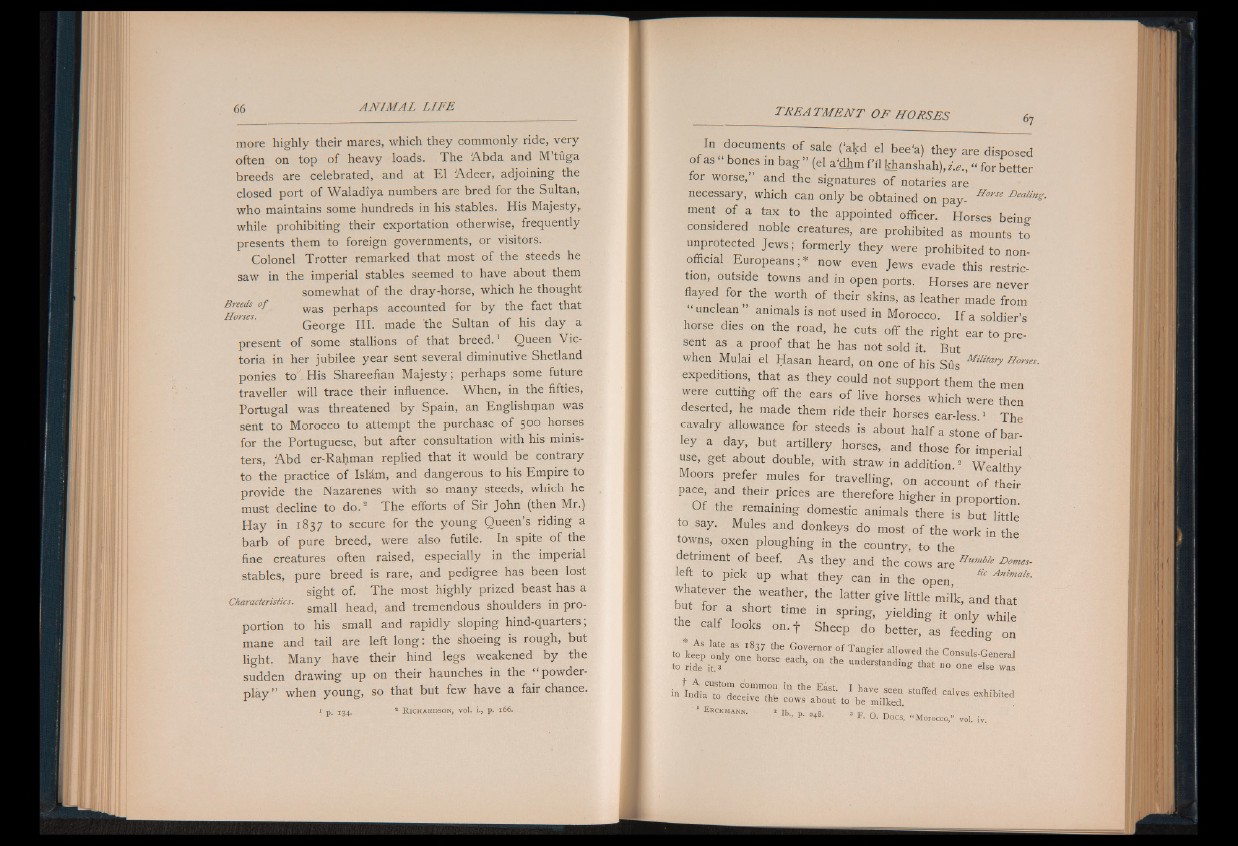
more highly their mares, which they commonly ride, very
often on top of heavy loads. The Abda and M’tuga
breeds are celebrated, and at El Adeer, adjoining the
closed port of Waladiya numbers are bred for the Sultan,
who maintains some hundreds in his stables. His Majesty,,
while prohibiting their exportation otherwise, frequently
presents them to foreign governments, or visitors.
Colonel Trotter remarked that most of the steeds he
saw in the imperial stables seemed to have about them
somewhat of the dray-horse, which he thought
Breeds o f was perhaps accounted for by the fact that
George III. made the Sultan o f his day a
present of some stallions of that breed.’ Queen Victoria
in her jubilee year sent several diminutive Shetland
ponies to' His Shareefian Majesty; perhaps some future
traveller will trace their influence. When, in the fifties,
Portugal was threatened by Spain, an Englishman was
sent to Morocco to attempt the purchase of 500 horses
for the Portuguese, but after consultation with his ministers,
A b d er-Rahman replied that it would be contrary
to the practice of Islam, and dangerous to his Empire to
provide the Nazarenes with so many steeds, which he
must decline to d o .2 The efforts of Sir John (then Mr.)
Hay in 1837 to secure for the young Queen’s riding a
barb of pure breed, were also futile. In spite of the
fine creatures often raised, especially in the imperial
stables, pure breed is rare, and pedigree has been lost
sight of. The most highly prized beast has a
Characteristics. sm a ll h e a ^ and tremendous shoulders in proportion
to his small and rapidly sloping hind-quarters;
mane and tail are left long: the shoeing is rough, but
light. Many have their hind legs weakened by the
sudden drawing up on their haunches in the “ powder-
play ” when young, so that but few have a fair chance.
1 p. 134. 2 R i c h a r d s o n , vol. i., p. 166.
m oocuments of sale ('akd el bee’a) they are disposed
of as bones m bag ” (el a ’dhm f il khanshah), i.e., “ for better
for worse,” and the signatures of notaries are
necessary, which can only be obtained on pay- * ’% DealinS-
ment o f a tax to the appointed officer. Horses being-
considered noble creatures, are prohibited as mounts to
unprotected Jews; formerly they were prohibited to nonofficial
Europeans; * now even Jews evade this restriction,
outside towns and in open ports. Horses are never
flayed for the worth of their skins, as leather made from
“ unclean ” animals is not used in Morocco. I f a soldier’s
horse dies on the road, he cuts off the right ear to present
as a proof that he has not sold it. But
when Mulai el Hasan heard, on one of his Sus miitaiy Worses.
expeditions, that as they could not support them the men
were cutting off the ears of live horses which were then
deserted, he made them ride their horses ear-less 1 The
cavalry allowance for steeds is about half a stone ofbar-
ey a day, but artillery horses, and those for imperial
use, get about double, with straw in addition.2 Wealthy
Moors prefer mules for travelling, on account o f their
pace and their prices are therefore higher in proportion.
e remammg domestic animals there is but little
to say. Mules and donkeys do most of the work in the
towns, oxen ploughing in the country, to the
detriment o f beef. As they and the cows are Humble Romes-
left to pick up what they can in the open *
whatever ,he weather, the latter give little rniik, and that
ut for a short time in spring, yielding it only while
•he calf looks o n . f Sheep do better, as feeding on
to keeD ml “ H i f i t G° vernor of Taogier allowed the Consuls-General
to ride it. 3 °ne ^ ’ ° n the " “ ¿«-standing that no one else was
“ ira
1 E r c km a n n . j l b n 3 rv -r-v
’ ^ ’ F. O. Docs, “ Morocco,” vol. iv.